Heineken's Business Essentials: Competitive Strategies and Analysis
VerifiedAdded on 2023/03/31
|9
|2230
|486
Report
AI Summary
This report provides a comprehensive analysis of Heineken, a leading international beverage company, focusing on its competitive landscape and essential business strategies. It employs Porter's Five Forces model to assess Heineken's market position, highlighting factors such as buyer and supplier power, the threat of substitutes, and industry rivalry. The report also includes a SWOT analysis, identifying Heineken's strengths, weaknesses, opportunities, and threats, particularly in relation to its competitor, United Breweries Group (UB). Furthermore, it delves into Heineken's supply chain management, covering aspects like automotive logistics, transport procurement, e-fulfillment assessment, and demand planning, and examines various pricing strategies, including margin-based pricing, skimming prices, and decoy pricing, to understand how Heineken maintains its competitive edge and market share.

BUSINESSES
ESSENTIALS
ESSENTIALS
Paraphrase This Document
Need a fresh take? Get an instant paraphrase of this document with our AI Paraphraser
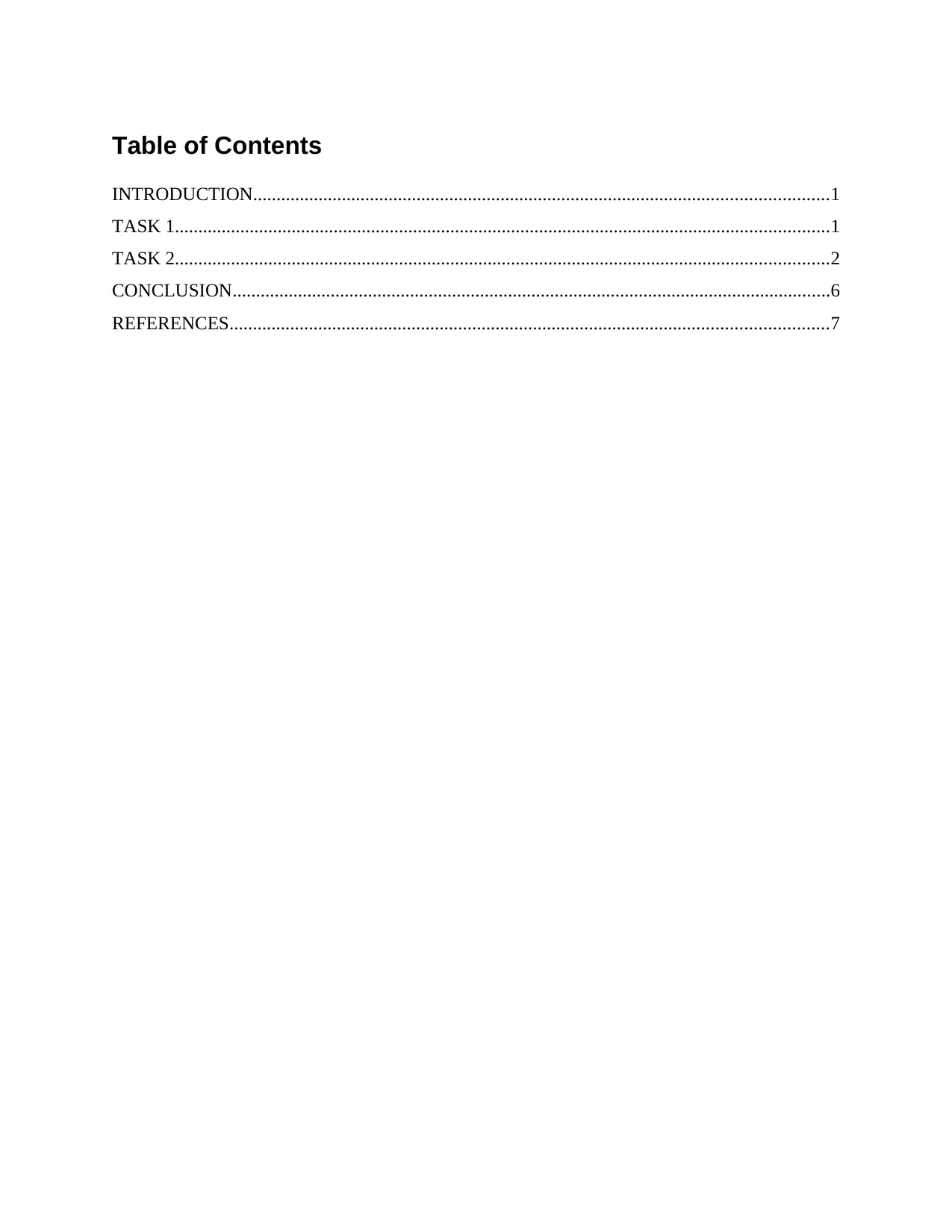
Table of Contents
INTRODUCTION...........................................................................................................................1
TASK 1............................................................................................................................................1
TASK 2............................................................................................................................................2
CONCLUSION................................................................................................................................6
REFERENCES................................................................................................................................7
INTRODUCTION...........................................................................................................................1
TASK 1............................................................................................................................................1
TASK 2............................................................................................................................................2
CONCLUSION................................................................................................................................6
REFERENCES................................................................................................................................7
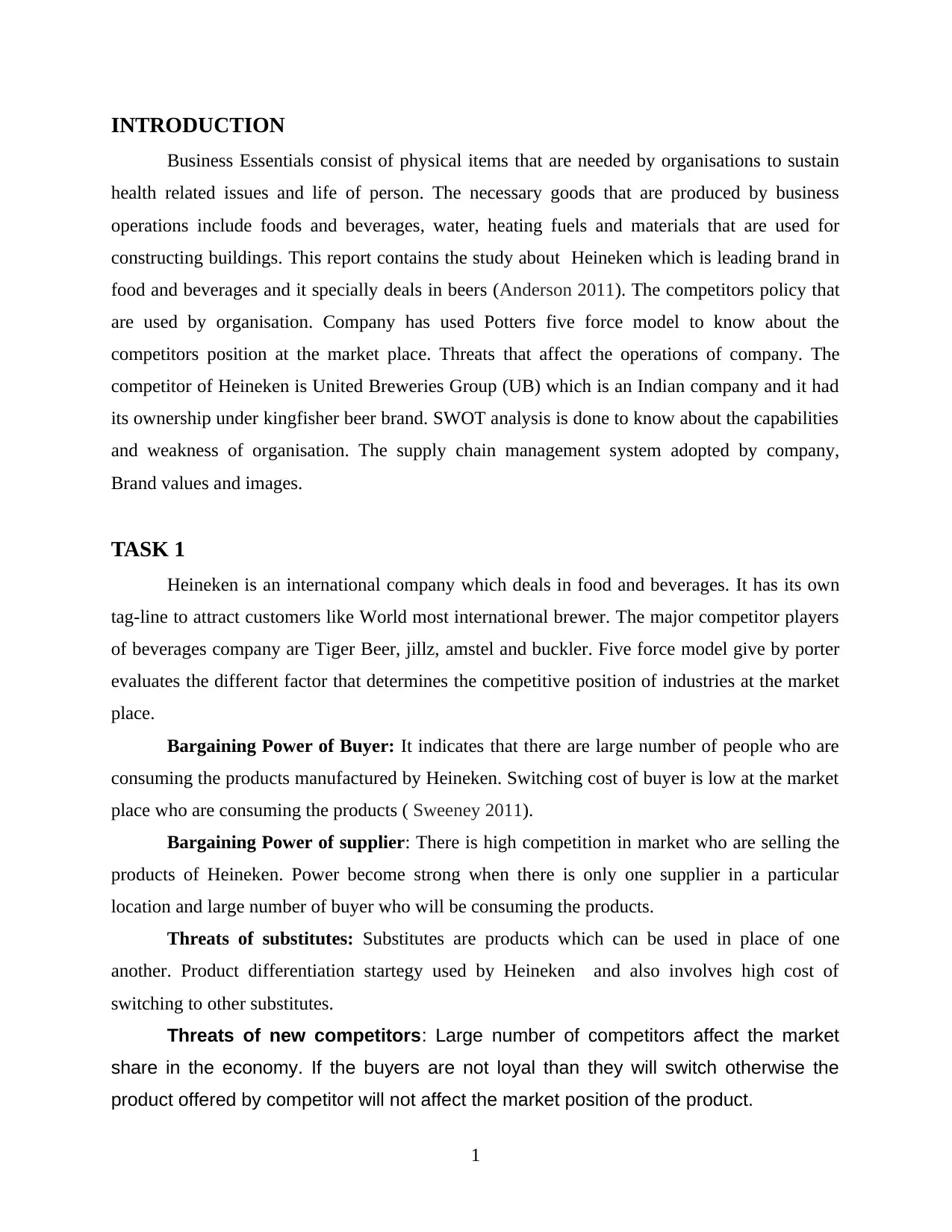
INTRODUCTION
Business Essentials consist of physical items that are needed by organisations to sustain
health related issues and life of person. The necessary goods that are produced by business
operations include foods and beverages, water, heating fuels and materials that are used for
constructing buildings. This report contains the study about Heineken which is leading brand in
food and beverages and it specially deals in beers (Anderson 2011). The competitors policy that
are used by organisation. Company has used Potters five force model to know about the
competitors position at the market place. Threats that affect the operations of company. The
competitor of Heineken is United Breweries Group (UB) which is an Indian company and it had
its ownership under kingfisher beer brand. SWOT analysis is done to know about the capabilities
and weakness of organisation. The supply chain management system adopted by company,
Brand values and images.
TASK 1
Heineken is an international company which deals in food and beverages. It has its own
tag-line to attract customers like World most international brewer. The major competitor players
of beverages company are Tiger Beer, jillz, amstel and buckler. Five force model give by porter
evaluates the different factor that determines the competitive position of industries at the market
place.
Bargaining Power of Buyer: It indicates that there are large number of people who are
consuming the products manufactured by Heineken. Switching cost of buyer is low at the market
place who are consuming the products ( Sweeney 2011).
Bargaining Power of supplier: There is high competition in market who are selling the
products of Heineken. Power become strong when there is only one supplier in a particular
location and large number of buyer who will be consuming the products.
Threats of substitutes: Substitutes are products which can be used in place of one
another. Product differentiation startegy used by Heineken and also involves high cost of
switching to other substitutes.
Threats of new competitors: Large number of competitors affect the market
share in the economy. If the buyers are not loyal than they will switch otherwise the
product offered by competitor will not affect the market position of the product.
1
Business Essentials consist of physical items that are needed by organisations to sustain
health related issues and life of person. The necessary goods that are produced by business
operations include foods and beverages, water, heating fuels and materials that are used for
constructing buildings. This report contains the study about Heineken which is leading brand in
food and beverages and it specially deals in beers (Anderson 2011). The competitors policy that
are used by organisation. Company has used Potters five force model to know about the
competitors position at the market place. Threats that affect the operations of company. The
competitor of Heineken is United Breweries Group (UB) which is an Indian company and it had
its ownership under kingfisher beer brand. SWOT analysis is done to know about the capabilities
and weakness of organisation. The supply chain management system adopted by company,
Brand values and images.
TASK 1
Heineken is an international company which deals in food and beverages. It has its own
tag-line to attract customers like World most international brewer. The major competitor players
of beverages company are Tiger Beer, jillz, amstel and buckler. Five force model give by porter
evaluates the different factor that determines the competitive position of industries at the market
place.
Bargaining Power of Buyer: It indicates that there are large number of people who are
consuming the products manufactured by Heineken. Switching cost of buyer is low at the market
place who are consuming the products ( Sweeney 2011).
Bargaining Power of supplier: There is high competition in market who are selling the
products of Heineken. Power become strong when there is only one supplier in a particular
location and large number of buyer who will be consuming the products.
Threats of substitutes: Substitutes are products which can be used in place of one
another. Product differentiation startegy used by Heineken and also involves high cost of
switching to other substitutes.
Threats of new competitors: Large number of competitors affect the market
share in the economy. If the buyers are not loyal than they will switch otherwise the
product offered by competitor will not affect the market position of the product.
1
⊘ This is a preview!⊘
Do you want full access?
Subscribe today to unlock all pages.

Trusted by 1+ million students worldwide
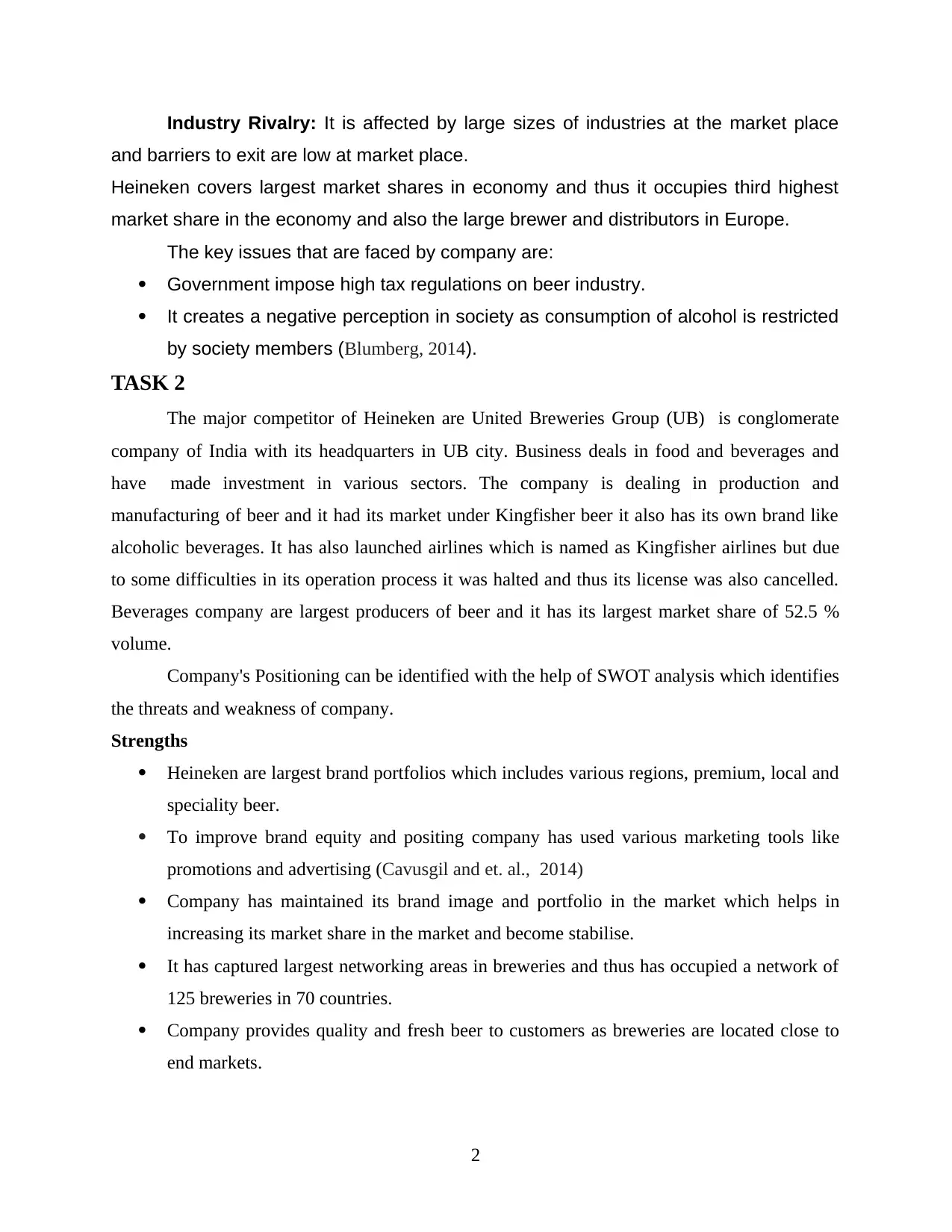
Industry Rivalry: It is affected by large sizes of industries at the market place
and barriers to exit are low at market place.
Heineken covers largest market shares in economy and thus it occupies third highest
market share in the economy and also the large brewer and distributors in Europe.
The key issues that are faced by company are:
Government impose high tax regulations on beer industry.
It creates a negative perception in society as consumption of alcohol is restricted
by society members (Blumberg, 2014).
TASK 2
The major competitor of Heineken are United Breweries Group (UB) is conglomerate
company of India with its headquarters in UB city. Business deals in food and beverages and
have made investment in various sectors. The company is dealing in production and
manufacturing of beer and it had its market under Kingfisher beer it also has its own brand like
alcoholic beverages. It has also launched airlines which is named as Kingfisher airlines but due
to some difficulties in its operation process it was halted and thus its license was also cancelled.
Beverages company are largest producers of beer and it has its largest market share of 52.5 %
volume.
Company's Positioning can be identified with the help of SWOT analysis which identifies
the threats and weakness of company.
Strengths
Heineken are largest brand portfolios which includes various regions, premium, local and
speciality beer.
To improve brand equity and positing company has used various marketing tools like
promotions and advertising (Cavusgil and et. al., 2014)
Company has maintained its brand image and portfolio in the market which helps in
increasing its market share in the market and become stabilise.
It has captured largest networking areas in breweries and thus has occupied a network of
125 breweries in 70 countries.
Company provides quality and fresh beer to customers as breweries are located close to
end markets.
2
and barriers to exit are low at market place.
Heineken covers largest market shares in economy and thus it occupies third highest
market share in the economy and also the large brewer and distributors in Europe.
The key issues that are faced by company are:
Government impose high tax regulations on beer industry.
It creates a negative perception in society as consumption of alcohol is restricted
by society members (Blumberg, 2014).
TASK 2
The major competitor of Heineken are United Breweries Group (UB) is conglomerate
company of India with its headquarters in UB city. Business deals in food and beverages and
have made investment in various sectors. The company is dealing in production and
manufacturing of beer and it had its market under Kingfisher beer it also has its own brand like
alcoholic beverages. It has also launched airlines which is named as Kingfisher airlines but due
to some difficulties in its operation process it was halted and thus its license was also cancelled.
Beverages company are largest producers of beer and it has its largest market share of 52.5 %
volume.
Company's Positioning can be identified with the help of SWOT analysis which identifies
the threats and weakness of company.
Strengths
Heineken are largest brand portfolios which includes various regions, premium, local and
speciality beer.
To improve brand equity and positing company has used various marketing tools like
promotions and advertising (Cavusgil and et. al., 2014)
Company has maintained its brand image and portfolio in the market which helps in
increasing its market share in the market and become stabilise.
It has captured largest networking areas in breweries and thus has occupied a network of
125 breweries in 70 countries.
Company provides quality and fresh beer to customers as breweries are located close to
end markets.
2
Paraphrase This Document
Need a fresh take? Get an instant paraphrase of this document with our AI Paraphraser
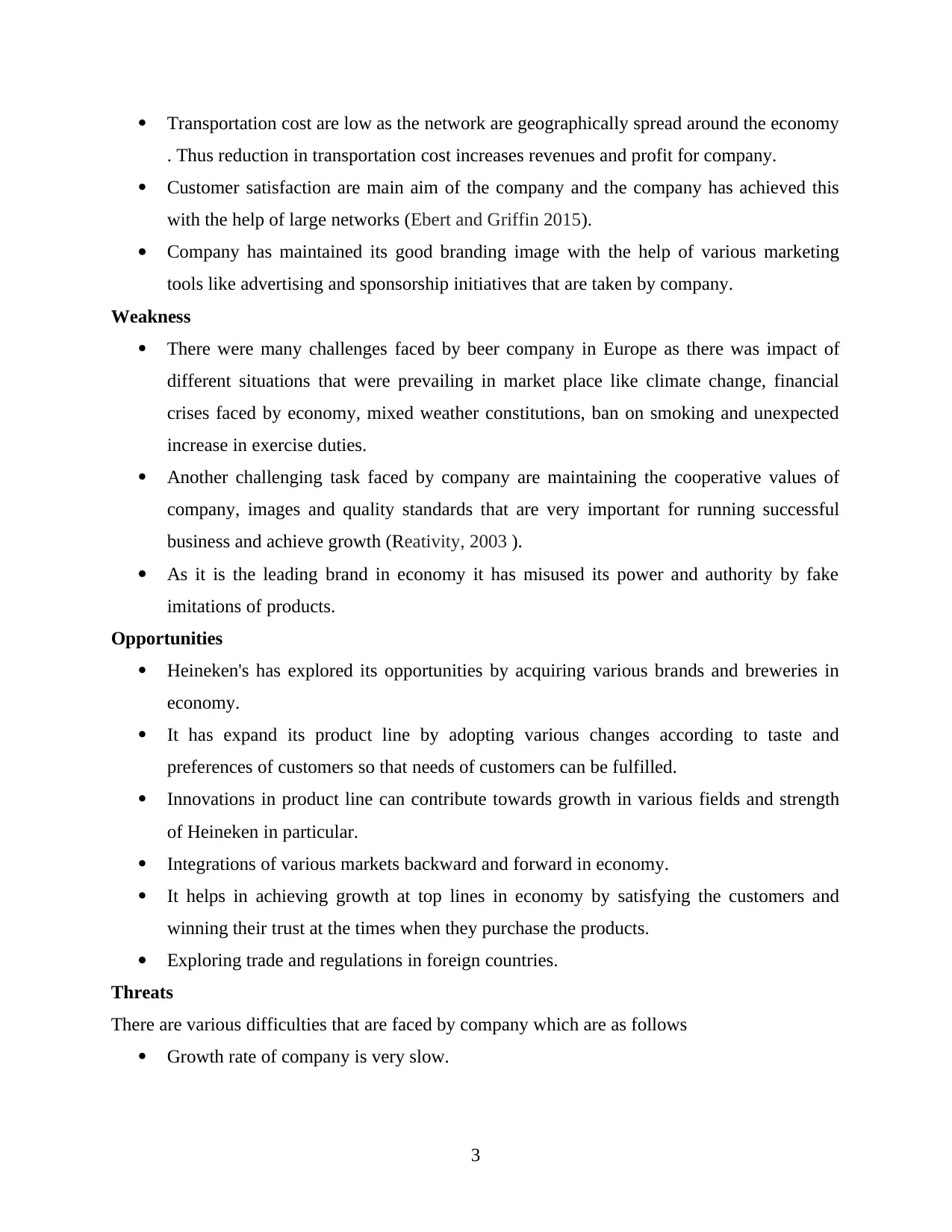
Transportation cost are low as the network are geographically spread around the economy
. Thus reduction in transportation cost increases revenues and profit for company.
Customer satisfaction are main aim of the company and the company has achieved this
with the help of large networks (Ebert and Griffin 2015).
Company has maintained its good branding image with the help of various marketing
tools like advertising and sponsorship initiatives that are taken by company.
Weakness
There were many challenges faced by beer company in Europe as there was impact of
different situations that were prevailing in market place like climate change, financial
crises faced by economy, mixed weather constitutions, ban on smoking and unexpected
increase in exercise duties.
Another challenging task faced by company are maintaining the cooperative values of
company, images and quality standards that are very important for running successful
business and achieve growth (Reativity, 2003 ).
As it is the leading brand in economy it has misused its power and authority by fake
imitations of products.
Opportunities
Heineken's has explored its opportunities by acquiring various brands and breweries in
economy.
It has expand its product line by adopting various changes according to taste and
preferences of customers so that needs of customers can be fulfilled.
Innovations in product line can contribute towards growth in various fields and strength
of Heineken in particular.
Integrations of various markets backward and forward in economy.
It helps in achieving growth at top lines in economy by satisfying the customers and
winning their trust at the times when they purchase the products.
Exploring trade and regulations in foreign countries.
Threats
There are various difficulties that are faced by company which are as follows
Growth rate of company is very slow.
3
. Thus reduction in transportation cost increases revenues and profit for company.
Customer satisfaction are main aim of the company and the company has achieved this
with the help of large networks (Ebert and Griffin 2015).
Company has maintained its good branding image with the help of various marketing
tools like advertising and sponsorship initiatives that are taken by company.
Weakness
There were many challenges faced by beer company in Europe as there was impact of
different situations that were prevailing in market place like climate change, financial
crises faced by economy, mixed weather constitutions, ban on smoking and unexpected
increase in exercise duties.
Another challenging task faced by company are maintaining the cooperative values of
company, images and quality standards that are very important for running successful
business and achieve growth (Reativity, 2003 ).
As it is the leading brand in economy it has misused its power and authority by fake
imitations of products.
Opportunities
Heineken's has explored its opportunities by acquiring various brands and breweries in
economy.
It has expand its product line by adopting various changes according to taste and
preferences of customers so that needs of customers can be fulfilled.
Innovations in product line can contribute towards growth in various fields and strength
of Heineken in particular.
Integrations of various markets backward and forward in economy.
It helps in achieving growth at top lines in economy by satisfying the customers and
winning their trust at the times when they purchase the products.
Exploring trade and regulations in foreign countries.
Threats
There are various difficulties that are faced by company which are as follows
Growth rate of company is very slow.
3
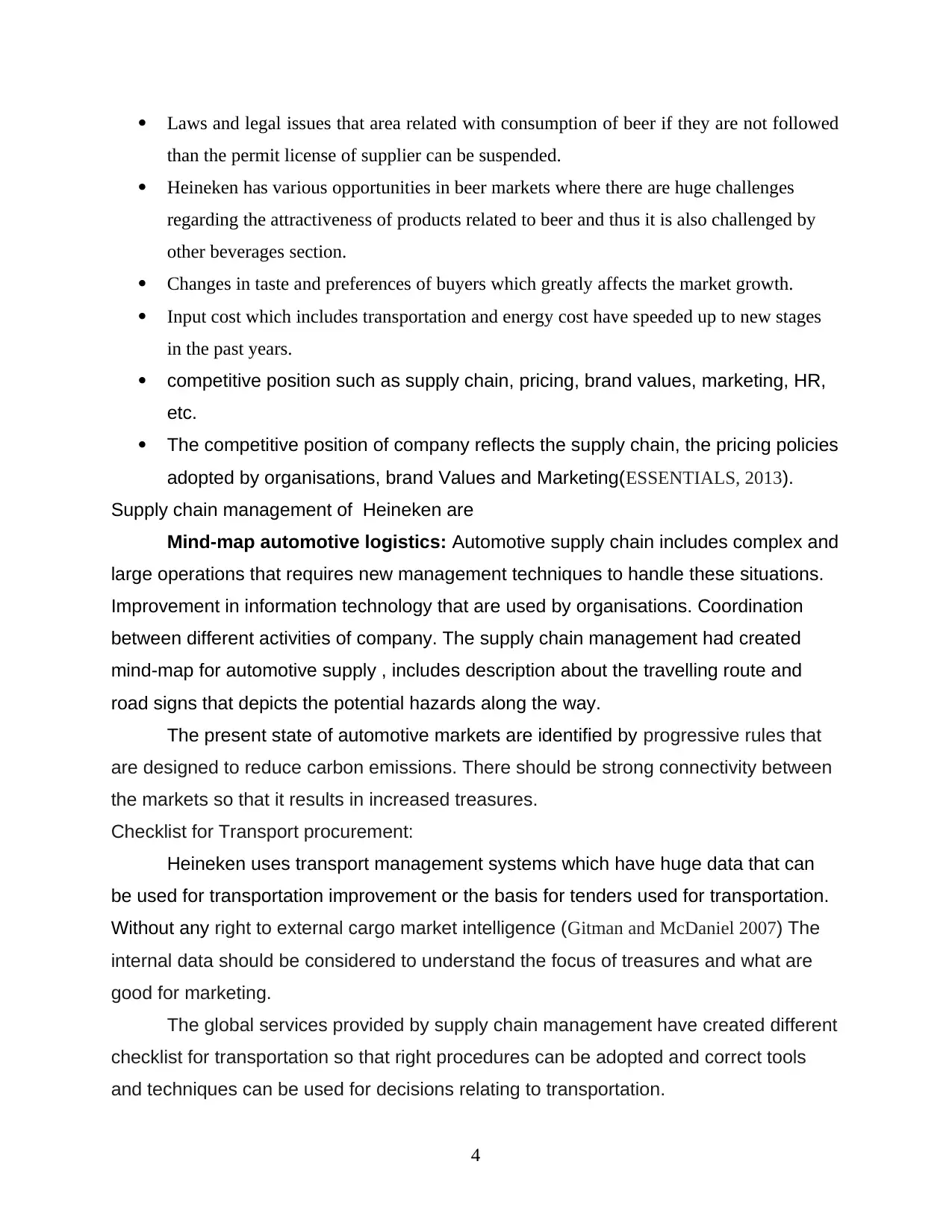
Laws and legal issues that area related with consumption of beer if they are not followed
than the permit license of supplier can be suspended.
Heineken has various opportunities in beer markets where there are huge challenges
regarding the attractiveness of products related to beer and thus it is also challenged by
other beverages section.
Changes in taste and preferences of buyers which greatly affects the market growth.
Input cost which includes transportation and energy cost have speeded up to new stages
in the past years.
competitive position such as supply chain, pricing, brand values, marketing, HR,
etc.
The competitive position of company reflects the supply chain, the pricing policies
adopted by organisations, brand Values and Marketing(ESSENTIALS, 2013).
Supply chain management of Heineken are
Mind-map automotive logistics: Automotive supply chain includes complex and
large operations that requires new management techniques to handle these situations.
Improvement in information technology that are used by organisations. Coordination
between different activities of company. The supply chain management had created
mind-map for automotive supply , includes description about the travelling route and
road signs that depicts the potential hazards along the way.
The present state of automotive markets are identified by progressive rules that
are designed to reduce carbon emissions. There should be strong connectivity between
the markets so that it results in increased treasures.
Checklist for Transport procurement:
Heineken uses transport management systems which have huge data that can
be used for transportation improvement or the basis for tenders used for transportation.
Without any right to external cargo market intelligence (Gitman and McDaniel 2007) The
internal data should be considered to understand the focus of treasures and what are
good for marketing.
The global services provided by supply chain management have created different
checklist for transportation so that right procedures can be adopted and correct tools
and techniques can be used for decisions relating to transportation.
4
than the permit license of supplier can be suspended.
Heineken has various opportunities in beer markets where there are huge challenges
regarding the attractiveness of products related to beer and thus it is also challenged by
other beverages section.
Changes in taste and preferences of buyers which greatly affects the market growth.
Input cost which includes transportation and energy cost have speeded up to new stages
in the past years.
competitive position such as supply chain, pricing, brand values, marketing, HR,
etc.
The competitive position of company reflects the supply chain, the pricing policies
adopted by organisations, brand Values and Marketing(ESSENTIALS, 2013).
Supply chain management of Heineken are
Mind-map automotive logistics: Automotive supply chain includes complex and
large operations that requires new management techniques to handle these situations.
Improvement in information technology that are used by organisations. Coordination
between different activities of company. The supply chain management had created
mind-map for automotive supply , includes description about the travelling route and
road signs that depicts the potential hazards along the way.
The present state of automotive markets are identified by progressive rules that
are designed to reduce carbon emissions. There should be strong connectivity between
the markets so that it results in increased treasures.
Checklist for Transport procurement:
Heineken uses transport management systems which have huge data that can
be used for transportation improvement or the basis for tenders used for transportation.
Without any right to external cargo market intelligence (Gitman and McDaniel 2007) The
internal data should be considered to understand the focus of treasures and what are
good for marketing.
The global services provided by supply chain management have created different
checklist for transportation so that right procedures can be adopted and correct tools
and techniques can be used for decisions relating to transportation.
4
⊘ This is a preview!⊘
Do you want full access?
Subscribe today to unlock all pages.

Trusted by 1+ million students worldwide
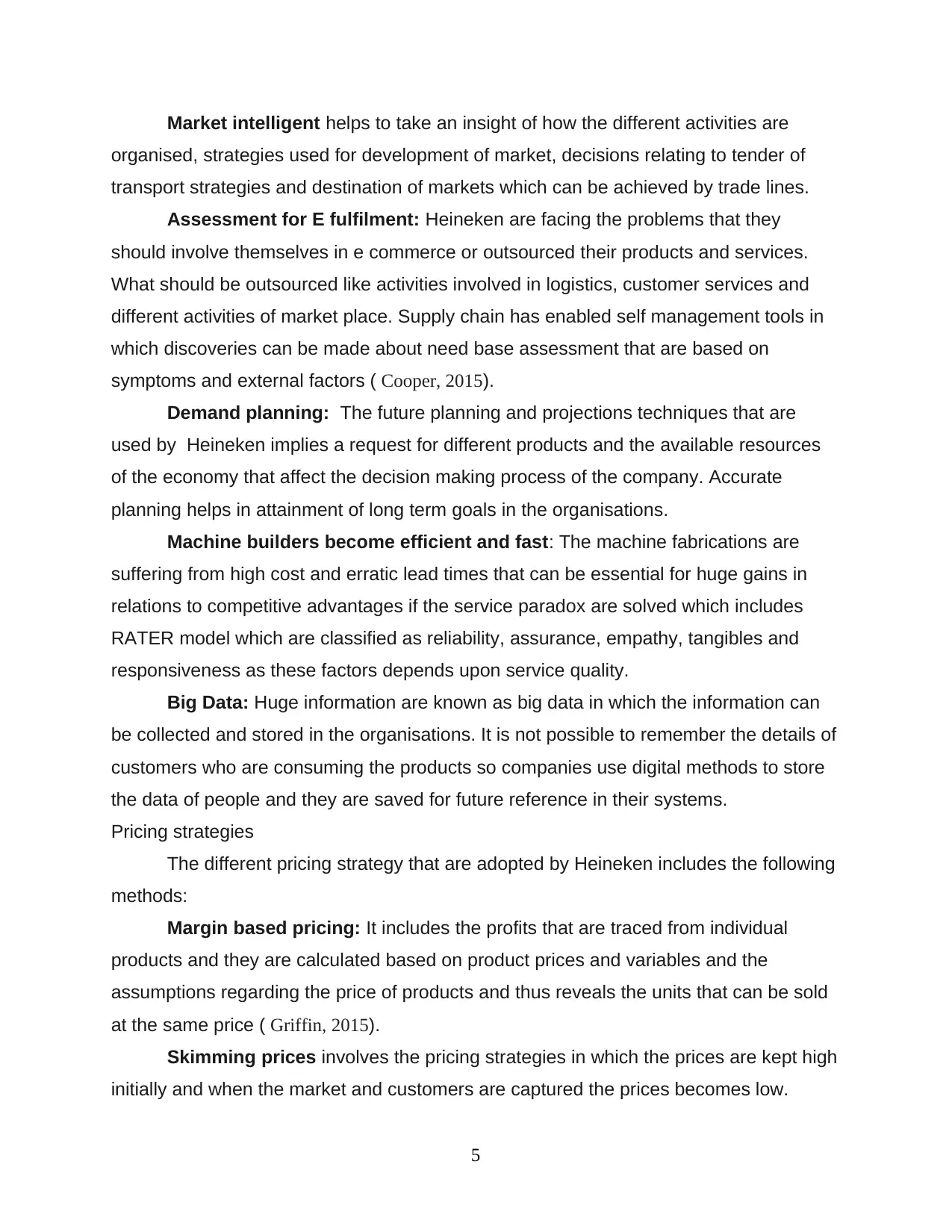
Market intelligent helps to take an insight of how the different activities are
organised, strategies used for development of market, decisions relating to tender of
transport strategies and destination of markets which can be achieved by trade lines.
Assessment for E fulfilment: Heineken are facing the problems that they
should involve themselves in e commerce or outsourced their products and services.
What should be outsourced like activities involved in logistics, customer services and
different activities of market place. Supply chain has enabled self management tools in
which discoveries can be made about need base assessment that are based on
symptoms and external factors ( Cooper, 2015).
Demand planning: The future planning and projections techniques that are
used by Heineken implies a request for different products and the available resources
of the economy that affect the decision making process of the company. Accurate
planning helps in attainment of long term goals in the organisations.
Machine builders become efficient and fast: The machine fabrications are
suffering from high cost and erratic lead times that can be essential for huge gains in
relations to competitive advantages if the service paradox are solved which includes
RATER model which are classified as reliability, assurance, empathy, tangibles and
responsiveness as these factors depends upon service quality.
Big Data: Huge information are known as big data in which the information can
be collected and stored in the organisations. It is not possible to remember the details of
customers who are consuming the products so companies use digital methods to store
the data of people and they are saved for future reference in their systems.
Pricing strategies
The different pricing strategy that are adopted by Heineken includes the following
methods:
Margin based pricing: It includes the profits that are traced from individual
products and they are calculated based on product prices and variables and the
assumptions regarding the price of products and thus reveals the units that can be sold
at the same price ( Griffin, 2015).
Skimming prices involves the pricing strategies in which the prices are kept high
initially and when the market and customers are captured the prices becomes low.
5
organised, strategies used for development of market, decisions relating to tender of
transport strategies and destination of markets which can be achieved by trade lines.
Assessment for E fulfilment: Heineken are facing the problems that they
should involve themselves in e commerce or outsourced their products and services.
What should be outsourced like activities involved in logistics, customer services and
different activities of market place. Supply chain has enabled self management tools in
which discoveries can be made about need base assessment that are based on
symptoms and external factors ( Cooper, 2015).
Demand planning: The future planning and projections techniques that are
used by Heineken implies a request for different products and the available resources
of the economy that affect the decision making process of the company. Accurate
planning helps in attainment of long term goals in the organisations.
Machine builders become efficient and fast: The machine fabrications are
suffering from high cost and erratic lead times that can be essential for huge gains in
relations to competitive advantages if the service paradox are solved which includes
RATER model which are classified as reliability, assurance, empathy, tangibles and
responsiveness as these factors depends upon service quality.
Big Data: Huge information are known as big data in which the information can
be collected and stored in the organisations. It is not possible to remember the details of
customers who are consuming the products so companies use digital methods to store
the data of people and they are saved for future reference in their systems.
Pricing strategies
The different pricing strategy that are adopted by Heineken includes the following
methods:
Margin based pricing: It includes the profits that are traced from individual
products and they are calculated based on product prices and variables and the
assumptions regarding the price of products and thus reveals the units that can be sold
at the same price ( Griffin, 2015).
Skimming prices involves the pricing strategies in which the prices are kept high
initially and when the market and customers are captured the prices becomes low.
5
Paraphrase This Document
Need a fresh take? Get an instant paraphrase of this document with our AI Paraphraser
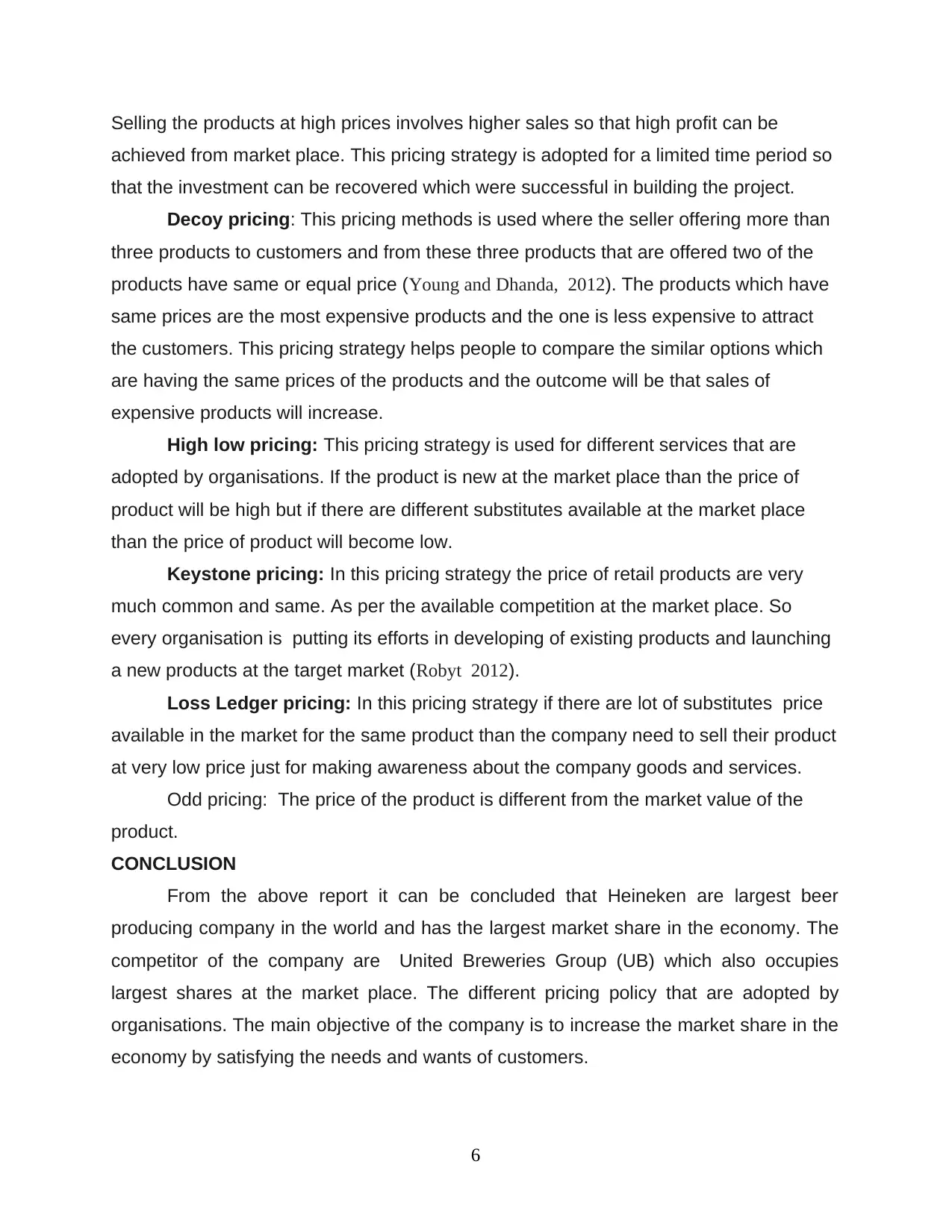
Selling the products at high prices involves higher sales so that high profit can be
achieved from market place. This pricing strategy is adopted for a limited time period so
that the investment can be recovered which were successful in building the project.
Decoy pricing: This pricing methods is used where the seller offering more than
three products to customers and from these three products that are offered two of the
products have same or equal price (Young and Dhanda, 2012). The products which have
same prices are the most expensive products and the one is less expensive to attract
the customers. This pricing strategy helps people to compare the similar options which
are having the same prices of the products and the outcome will be that sales of
expensive products will increase.
High low pricing: This pricing strategy is used for different services that are
adopted by organisations. If the product is new at the market place than the price of
product will be high but if there are different substitutes available at the market place
than the price of product will become low.
Keystone pricing: In this pricing strategy the price of retail products are very
much common and same. As per the available competition at the market place. So
every organisation is putting its efforts in developing of existing products and launching
a new products at the target market (Robyt 2012).
Loss Ledger pricing: In this pricing strategy if there are lot of substitutes price
available in the market for the same product than the company need to sell their product
at very low price just for making awareness about the company goods and services.
Odd pricing: The price of the product is different from the market value of the
product.
CONCLUSION
From the above report it can be concluded that Heineken are largest beer
producing company in the world and has the largest market share in the economy. The
competitor of the company are United Breweries Group (UB) which also occupies
largest shares at the market place. The different pricing policy that are adopted by
organisations. The main objective of the company is to increase the market share in the
economy by satisfying the needs and wants of customers.
6
achieved from market place. This pricing strategy is adopted for a limited time period so
that the investment can be recovered which were successful in building the project.
Decoy pricing: This pricing methods is used where the seller offering more than
three products to customers and from these three products that are offered two of the
products have same or equal price (Young and Dhanda, 2012). The products which have
same prices are the most expensive products and the one is less expensive to attract
the customers. This pricing strategy helps people to compare the similar options which
are having the same prices of the products and the outcome will be that sales of
expensive products will increase.
High low pricing: This pricing strategy is used for different services that are
adopted by organisations. If the product is new at the market place than the price of
product will be high but if there are different substitutes available at the market place
than the price of product will become low.
Keystone pricing: In this pricing strategy the price of retail products are very
much common and same. As per the available competition at the market place. So
every organisation is putting its efforts in developing of existing products and launching
a new products at the target market (Robyt 2012).
Loss Ledger pricing: In this pricing strategy if there are lot of substitutes price
available in the market for the same product than the company need to sell their product
at very low price just for making awareness about the company goods and services.
Odd pricing: The price of the product is different from the market value of the
product.
CONCLUSION
From the above report it can be concluded that Heineken are largest beer
producing company in the world and has the largest market share in the economy. The
competitor of the company are United Breweries Group (UB) which also occupies
largest shares at the market place. The different pricing policy that are adopted by
organisations. The main objective of the company is to increase the market share in the
economy by satisfying the needs and wants of customers.
6
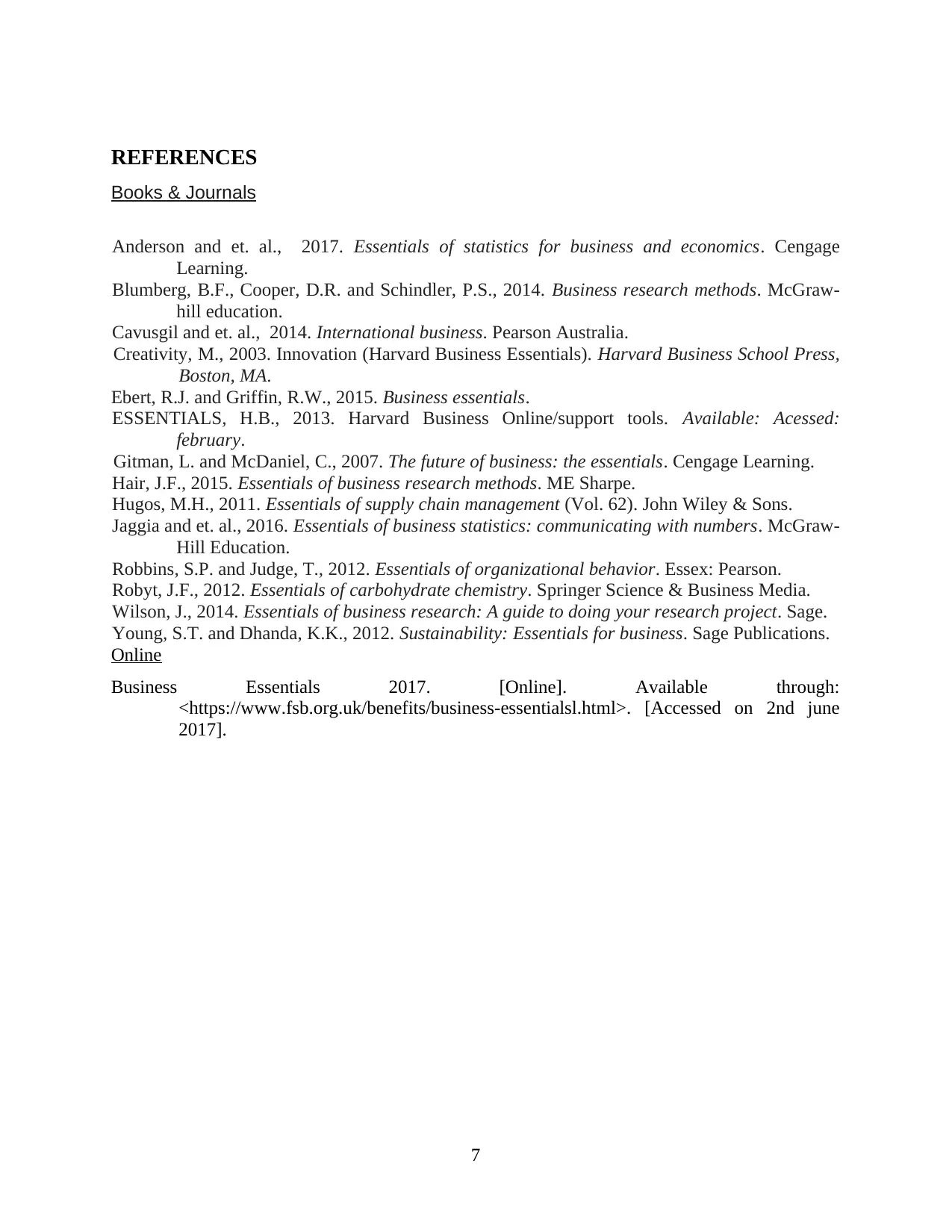
REFERENCES
Books & Journals
Anderson and et. al., 2017. Essentials of statistics for business and economics. Cengage
Learning.
Blumberg, B.F., Cooper, D.R. and Schindler, P.S., 2014. Business research methods. McGraw-
hill education.
Cavusgil and et. al., 2014. International business. Pearson Australia.
Creativity, M., 2003. Innovation (Harvard Business Essentials). Harvard Business School Press,
Boston, MA.
Ebert, R.J. and Griffin, R.W., 2015. Business essentials.
ESSENTIALS, H.B., 2013. Harvard Business Online/support tools. Available: Acessed:
february.
Gitman, L. and McDaniel, C., 2007. The future of business: the essentials. Cengage Learning.
Hair, J.F., 2015. Essentials of business research methods. ME Sharpe.
Hugos, M.H., 2011. Essentials of supply chain management (Vol. 62). John Wiley & Sons.
Jaggia and et. al., 2016. Essentials of business statistics: communicating with numbers. McGraw-
Hill Education.
Robbins, S.P. and Judge, T., 2012. Essentials of organizational behavior. Essex: Pearson.
Robyt, J.F., 2012. Essentials of carbohydrate chemistry. Springer Science & Business Media.
Wilson, J., 2014. Essentials of business research: A guide to doing your research project. Sage.
Young, S.T. and Dhanda, K.K., 2012. Sustainability: Essentials for business. Sage Publications.
Online
Business Essentials 2017. [Online]. Available through:
<https://www.fsb.org.uk/benefits/business-essentialsl.html>. [Accessed on 2nd june
2017].
7
Books & Journals
Anderson and et. al., 2017. Essentials of statistics for business and economics. Cengage
Learning.
Blumberg, B.F., Cooper, D.R. and Schindler, P.S., 2014. Business research methods. McGraw-
hill education.
Cavusgil and et. al., 2014. International business. Pearson Australia.
Creativity, M., 2003. Innovation (Harvard Business Essentials). Harvard Business School Press,
Boston, MA.
Ebert, R.J. and Griffin, R.W., 2015. Business essentials.
ESSENTIALS, H.B., 2013. Harvard Business Online/support tools. Available: Acessed:
february.
Gitman, L. and McDaniel, C., 2007. The future of business: the essentials. Cengage Learning.
Hair, J.F., 2015. Essentials of business research methods. ME Sharpe.
Hugos, M.H., 2011. Essentials of supply chain management (Vol. 62). John Wiley & Sons.
Jaggia and et. al., 2016. Essentials of business statistics: communicating with numbers. McGraw-
Hill Education.
Robbins, S.P. and Judge, T., 2012. Essentials of organizational behavior. Essex: Pearson.
Robyt, J.F., 2012. Essentials of carbohydrate chemistry. Springer Science & Business Media.
Wilson, J., 2014. Essentials of business research: A guide to doing your research project. Sage.
Young, S.T. and Dhanda, K.K., 2012. Sustainability: Essentials for business. Sage Publications.
Online
Business Essentials 2017. [Online]. Available through:
<https://www.fsb.org.uk/benefits/business-essentialsl.html>. [Accessed on 2nd june
2017].
7
⊘ This is a preview!⊘
Do you want full access?
Subscribe today to unlock all pages.

Trusted by 1+ million students worldwide
1 out of 9
Related Documents
Your All-in-One AI-Powered Toolkit for Academic Success.
+13062052269
info@desklib.com
Available 24*7 on WhatsApp / Email
![[object Object]](/_next/static/media/star-bottom.7253800d.svg)
Unlock your academic potential
Copyright © 2020–2025 A2Z Services. All Rights Reserved. Developed and managed by ZUCOL.




